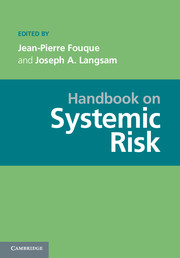Book contents
- Frontmatter
- Contents
- Contributors
- Introduction
- PART I DATA: THE PREREQUISITE FOR MANAGING SYSTEMIC RISK
- PART II STATISTICS AND SYSTEMIC RISK
- 6 Statistical Assessments of Systemic Risk Measures
- 7 Regime Switching Models and Risk Measurement Tools
- PART III MEASURING AND REGULATING SYSTEMIC RISK
- PART IV NETWORKS
- PART V SYSTEMIC RISK ANDMATHEMATICAL FINANCE
- PART VI COUNTERPARTY RISK AND SYSTEMIC RISK
- PART VII ALGORITHMIC TRADING
- PART VIII BEHAVIORAL FINANCE: THE PSYCHOLOGICAL DIMENSION OF SYSTEMIC RISK
- PART IX REGULATION
- PART X COMPUTATIONAL ISSUES AND REQUIREMENTS
- PART XI ACCOUNTING ISSUES
- References
6 - Statistical Assessments of Systemic Risk Measures
from PART II - STATISTICS AND SYSTEMIC RISK
Published online by Cambridge University Press: 05 June 2013
- Frontmatter
- Contents
- Contributors
- Introduction
- PART I DATA: THE PREREQUISITE FOR MANAGING SYSTEMIC RISK
- PART II STATISTICS AND SYSTEMIC RISK
- 6 Statistical Assessments of Systemic Risk Measures
- 7 Regime Switching Models and Risk Measurement Tools
- PART III MEASURING AND REGULATING SYSTEMIC RISK
- PART IV NETWORKS
- PART V SYSTEMIC RISK ANDMATHEMATICAL FINANCE
- PART VI COUNTERPARTY RISK AND SYSTEMIC RISK
- PART VII ALGORITHMIC TRADING
- PART VIII BEHAVIORAL FINANCE: THE PSYCHOLOGICAL DIMENSION OF SYSTEMIC RISK
- PART IX REGULATION
- PART X COMPUTATIONAL ISSUES AND REQUIREMENTS
- PART XI ACCOUNTING ISSUES
- References
Summary
Abstract In this chapter, we review existing statistical measures for systemic risk and discuss their strengths and weaknesses. Among them we discuss the Conditional Value-at-Risk (CoVaR) introduced by Adrian and Brunnermeier (2010) and the Systemic Expected Shortfall (SES) of Acharya, Pedersen, Philippon and Richardson (2011). As systemic risk is highly related to financial contagion, we will explain the drawbacks and advantages of looking at “coexceedances” (simultaneous extreme events) or at the local changes in “correlation” that have been proposed in the literature on financial contagion (Bae, Karolyi and Stulz (2003), Baig and Goldfajn (1999) and Forbes and Rigobon (2002)).
Introduction and background on systemic risk
During the financial crisis of 2007–2009, worldwide taxpayers had to bailout many financial institutions. Governments are now trying to understand why the regulation failed, why capital requirements were not enough and how a guaranty fund should be built to address the next financial crisis. To implement such a fund, one needs to understand the risk that each institution represents to the financial system and why regulatory capital requirements were not enough. In the financial and insurance industry, capital requirements have the following common properties. First, they depend solely on the distribution of the institution's risk and not on the outcomes in the different states of the world. Second, capital requirements and marginal calculations treat each institution in isolation. An important element is missing in the above assessment of risk: it is the dependency between the individual institution and the economy or the financial system. The regulation should “be regulating each bank as a function of both its joint (correlated) risk with other banks as well as its individual (bank-specific) risk” (Acharya (2009)).
- Type
- Chapter
- Information
- Handbook on Systemic Risk , pp. 165 - 179Publisher: Cambridge University PressPrint publication year: 2013
References
- 9
- Cited by

